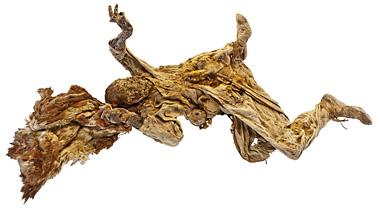PART. 2
Research objectives
Apart from the fundamental task of establishing a solid chronology, and recording the mining techniques used on site, the aim of the project is to analyse the social and economic background of individuals involved in the mining activities. The finds show an extraordinary state of preservation, thanks to being embedded in salt-enriched deposits, thus offering great potential for a variety of scientific approaches to answer questions concerning mining activity, interregionality, palaeolandscape and socio-cultural aspects. An international team has been assembled to conduct research in the disciplines of:
- Archaeobotany
- Archaeozoology
- aDNA analysis
- Geomorphology
- Isotope analysis
- Mining archaeology
- Palaeoparasitology
- Palaeopathology, including computed tomography, histology and experimental work
- Physical anthropology, with a main focus on osteology
- Textile research
Results and prospects

Figure 5. Salt mummy no. 4, Archaeological Museum Zanjan (photograph: Deutsches Bergbau-Museum).
Results from the detailed anatomical analysis of the salt mummies (Figure 5) have led to a revision of the presumed number of individuals found at the site: some body parts, previously thought to belong to a single individual, come in fact from different bodies, thus raising their number to at least eight individuals. Isotopic analyses have shown that not all miners came from the Iranian Central Plateau (the Tehran-Qazvin Plain) but from the more arid steppe regions of north-eastern Iran and central Asia, as well as from the coastal areas around the Caspian Sea.
Palaeoparasitology, histological, and isotopic analyses provide us with information on taphonomic and palaeopathological questions related to the state of health, sanitary conditions and diet during the individuals' lifetime, while DNA studies shed light on ancestry and kinship, as well as medically relevant genes. In this context, the mummies will be investigated in an interdisciplinary archaeozoological and archaeobotanical study of the large number of human and animal faeces found inside the mine, providing clues for the subsistence of the miners. The animal bone remains indicate that the miners consumed sheep and goat, though the consumption of cattle (horn containers at the site point to the presence of cattle) and pig cannot be excluded; the consumption of the latter is certainly possible, as they were widely consumed on the Iranian Plateau in the periods under study. Archaeobotanical records indicate that different cultivated plants were used, hinting at a well-established agricultural background. Deforestation was less severe than today and several tree species found their way inside the mine as tools. The excellent condition of the textiles and other organic artefacts inside the mine has allowed comprehensive analyses to be undertaken, ranging from the resources used for fibre production, via processing, to the dyes used for colouring different parts of the garments (Figure 6). The diachronic nature of the textile finds, which are well-excavated and radiocarbon dated, gives insight into changes in garment types, weave patterns and the morphology of fibre through time.

Figure 6. Textile fragment, length c. 520 mm, Archaeological Museum Zanjan (photograph: Miras Farhangi/Deutsches Bergbau-Museum).
The integration of the results obtained so far has produced a first holistic view of the salt mine and its miners. Examining the various artefacts and ecofacts in their stratigraphic and chronological setting has allowed the research team to differentiate between the Achaemenid and Sassanian mining phases. During the Sassanian period mining was established within the surrounding landscape, and isotopic data indicate that supply was organised on a regional scale. In the Achaemenid period mining seems to have been organised on a different basis: there are indications that foreign miners were present (Ramaroli et al. 2010) and the lack of settlements in the vicinity, as well as the goods supplied and the high amount of ceramic vessels, suggest access from areas further away.
Acknowledgements
The authors gratefully acknowledge financial support by the DFG (German Research Foundation), the AHRC (Arts and Humanities Research Council), the Miras Farhangi, Zanjan and the Mäxi-Stiftung, Zürich. Furthermore we would like to thank the head of the Pajouheshkadeh-ye Miras Farhangi (ICAR) Dr Mir Eskandari and his staff, as well as Y. Naghizadeh, head of the Zanjan branch of the Miras Farhangi for fruitful cooperation and organisational support. The Deutsches Archäologisches Institut (DAI) helped and continues to help us in many ways, particularly M. Hakimpour, the heart and soul of the Tehran office. Further information can be found on the project website: http://www.saltmen-iran.com.
References
- AALI, A. 2005. Salt men. Tehran: Iranian Center for Archaeological Research, ICHTO.
- AALI, A., T. STöLLNER, A. ABAR & F. RüHLI. 2012. The salt men of Iran: the salt mine of Douzlakh, Chehrabad. Archäologisches Korrespondenzblatt 42/1: 61–81.
- POLLARD, A.M., D.R. BROTHWELL, A. AALI, S. BUCKLEY, H. FAZELI, M. HADIAN DEHKORDI, T. HOLDEN, A.K.G. JONES, J.J. SHOKOUHI, R. VATANDOUST & A.S. WILSON. 2008. Below the salt: a preliminary study of the dating and biology of five salt-preserved bodies from Zanjan province, Iran.Iran 46: 135–50.
- RAMAROLI, V., J. HAMILTON, P. DITCHFIELD, H. FAZELI, A. AALI, R.A.E. CONINGHAM & A.M. POLLARD. 2010. The Chehr Abad "salt men" and the isotopic ecology of humans in ancient Iran. American Journal of Physical Anthropology 143: 343–54.
- RCCCR 1998. Salt man. Scientific investigations carried out on salt man mummified remains and its artifacts. Tehran: Research Center for Conservation of Cultural Relics.
- SHOKOUHI, J.J. 2005. Radiographic report on Saltman no. 4. Unpublished manuscript, Iranian Center for Archaeological Research, ICHTO, Tehran.
- VATANDOUST, A. & M. HADIAN DEHKORDI. 2005. "Saltman", a new archaeological discovery: scientific investigation and conservation, in E.R. Massa (ed.) Proceedings of Fifth World Congress on Mummy Studies, Turin, Italy, 2nd–5th September 2004. Journal of Biological Research 80: 236–42.